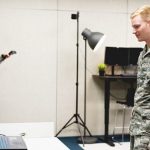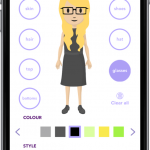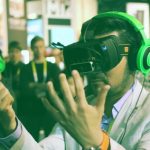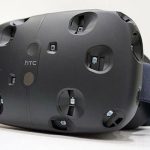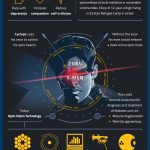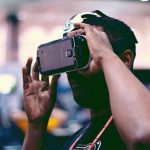With Icons Legion M Is Creating Pop-Culture Time Capsules And Pushing VR’s Limits
A tangle of cables slithers from a monitoring station in the garage of a house atop Hollywood’s Sunset Strip, up a narrow staircase brimming with artifacts and tchotchkes from an adventured life, and into a room overtaken by stereoscopic cameras, ambisonic sound equipment, and GoPro arrays.
The focus of all this technology: 94-year-old comic legend Stan Lee—co-creator of the Marvel Universe including Spider-Man, The X Men, and Iron Man, among numerous others—and his interviewer, director, and professional fanboy Kevin Smith, discussing Lee’s life, career, and marriage in an intimate setting at Lee’s home.
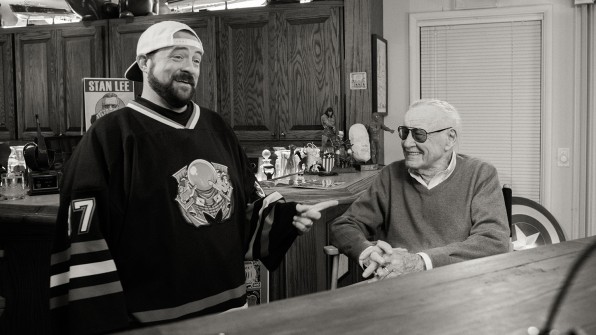
It’s the first step in a journey of firsts. The inaugural shoot of Icons: Face to Face, the first project from Legion M, the first that raises money through equity crowdfunding and gives contributors creative input and profit sharing.
It’s also the first use of a new configuration of virtual reality technology that captures its subjects at a fidelity never before used in VR. In fact, no VR headgear—or movie projector display for that matter—exists yet to play back the footage in its fullest level of detail. But it’s likely to in the future, which is the point of this project.
“We had an idea for an intimate interview with iconic people from today’s pop culture and entertainment, maybe doing new Icons every month,” says Legion M cofounder and president Jeff Annison. “But we want it to be able to stand the test of time, not just culturally, but technologically, to survive as a historical record. Most VR footage today is disposable. We wanted something that could keep up with advancements in state of the art.”
Their vision required hurdling two crucial technical challenges: placing the camera closer to its subjects than previously attempted in VR without optical distortion or destroying the three-dimensional perception, and recording at a resolution that abuts the edge of human perception.
“This is a pioneering effort in VR,” says Annison. While high-profile individuals have been interviewed in this format in the past, “no one has shot them as close and in the resolution as we have.”
Launched last March, Legion M opened its doors to non-accredited investors last summer, subsequently raising $1.2 million, part of which has gone toward stakes in such projects as the upcoming films Colossal (releasing April 7) and The Field Guide to Evil, and the digital TV series Pitch Elevator. It recently opened a second investing round that will allow it to raise up to $50 million (you can buy stock here). The Icons pilot is Legion’s first solely produced endeavor, though the company hopes to find producing partners for a subsequent series.

Idea-Driven Technology
The Icons experiment was a case of an interview driving the technology.
The idea began germinating last summer when Legion M’s Annison, cofounder/CEO Paul Scanlan, content acquisition head Terri Lubaroff, and content development head David Baxter began talking to VR companies about creating a more intimate viewing experience than had previously been done—enabling viewers to feel as though they were sitting with prominent individuals as they talked about their lives, dreams, regrets, what drives them, and visions for the future—and ensuring the footage’s adaptability to future display methods. But it didn’t begin to coalesce until they found a prominent individual who didn’t mind being a guinea pig in a grand technological experiment.
“We had this idea of trying to put you in the room with these legendary icons. And we got Stan on board—miraculously,” says Annison. “We pitched him this idea, and he really liked our model of a company owned by fans instead of a corporate conglomerate. In fact he said, ‘It’s such a good idea, I wish I’d thought of it myself!’”
Lee, in turn, chose Smith to interview him. “That was part of our idea for the series,” says Annison. “We wanted our interviewees to be completely at ease and open up. That’s why we did it at his house instead of a studio. Kevin has interviewed Stan probably a dozen times. He knew Stan, which questions to ask, and which had never been asked.” Ones that could meaningfully meander from Lee’s childhood in 1920s and ’30s New York, to creating Marvel comics, to his 70-year marriage, with his wife, Joanie, fielding questions as well.
Lee’s age further pressed the need for a record that could adapt well to evolving display technology. “It was daunting. This was a once-in-a-lifetime opportunity to get Stan at his house,” Annison adds. “We wanted to give people a hundred years from now the opportunity to sit down and spend an hour with him. That drove us to new technology, to do something that’s never been done before.”
The Legion M team spent the fall surveying state-of-the-art systems and opting for a 360-degree capture approach after educating themselves on types of VR. It found a technology partner in VR Playhouse, a Los Angeles boutique studio founded by Ian Forester specializing in VR, AR, and 360-degree production. It experimented for three months before arriving at a solution for a late January shoot.

Pushing the VR Boundaries
The two main challenges were getting the camera close enough to the subjects to “feel” like real life, and capture that experience at fidelity that could stand the test of time. That starts with resolution, but you also need to consider things like frame rate, color depth, and dynamic range.
Camera proximity. Most professional-grade 360-degree VR videos use the Jaunt One or Google Odyssey, the latter a stereoscopic panoramic capture array of 16 GoPro cameras positioned 6 to 10 feet from the subject. Forester’s team rigged a camera system that shot from 2.5 feet away.
Moving the camera had more to do with the aesthetic than longevity. Shooting from 10 feet “is not an intimate conversation with Stan; that’s Stan standing up and lecturing you,” says Annison. “VR Playhouse had to experiment to determine how close we could get before the optical distortion went crazy, the lenses couldn’t handle it, the 3D broke down, or it didn’t allow us to capture the full 360. There’s a lot of science that goes into it. And it gets more complicated when you’re filming it in stereo.”
Resolution. In VR, visual resolution is measured by the number of pixels per degree of viewing angle. Most VR headsets display 8-12. But Legion M was gunning for the edge of human perception—the point beyond which the human eye can no longer distinguish further clarity—which is 75 pixels per degree. VR Playhouse got it up to 72. By capturing at that resolution, the footage should remain sharp as display technology improves. And if displays eventually exceed that resolution, it won’t matter because the human eye can’t perceive it (at least until robotic implants are invented.)
“When you put on your VR headsets [today], it’s like being immersed in 1994 television. It’s not that sharp,” says Annison. “You can see compression artifacts (media distortion) and pixilation. It’s like that because of bottlenecks in displays, computer processing, file sizes, streaming, etc. But VR is in its infancy. All of these technological bottlenecks are going to go away in 5 to 10 years. We wanted to make sure that what we captured was completely future-proofed.”
The data captured for the Icons pilot is over 1,700 times bigger than an HDTV file. So, while it can be viewed in less detail in 2D and on different platforms, “there isn’t a TV, headset, or movie projector that exists today that can display it in the full resolution that we got,” says Annison.
The Solution. VR Playhouse recombined off-the-shelf components, experimenting with different camera and lens combinations before getting the desired effect with two 8K RED Digital cameras and ARRI Zeiss 8mm Ultra Prime rectilinear lenses for each eye. The depth of field was so shallow that the subjects’ arm movements had to confine to a very narrow area.
“It was a real challenge to find cameras,” says Annison. “8K cameras are around, but 8K that can handle 60 frames per second had only been out for a couple months. We had to call every camera rental place in town! When we got them–one of them only had three hours of use prior to us.”
After the live shoot concluded, the crew rotated the RED cameras to capture the rest of the room, to subsequently composite for a 360-degree effect. (They used an Odyssey concurrently for reference footage and comparison.)
The producers are finding their way creatively as well, exploring more of a sweeping narrative arc about their subjects’ overall lives than honing in on most notable aspects, as traditional interviews might. “We want something to stand the test of time–it’s just a different lens than people are used to today,” says Annison. “We asked our shareholders, ‘If you could step back in time to interview William Shakespeare, what would you want to ask him?’ and used a lot of their questions. We don’t just have Stan talking about his days at Marvel creating Spider-Man, we also have him talking about the day he met the love of his life, how he narrowly avoided going to the front lines in World War II, and telling us about the worst day of his life, and how he got through it.”
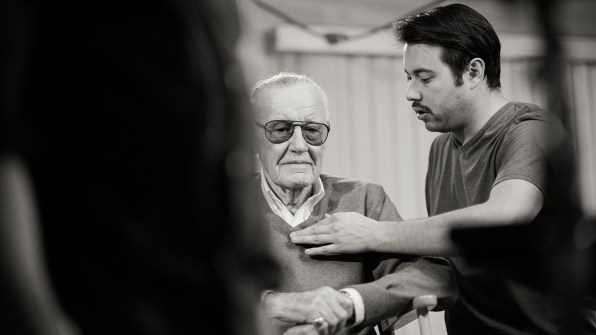
Next Steps
Legion M hopes to find producing partners to do more Icons interviews, given the expense. Even though VR Playhouse provided below-market rates, and some the 25 crew members volunteered, the 12-hour shoot still cost $40,000 with post-production expected to run upwards of $120,000.
So far, Pacific Rim and Pan’s Labyrinth director Guillermo del Toro has agreed to do an episode, and the company has routes to Stephen Hawking and Barack Obama. “Once we’ve seen the results with Stan, what worked and what didn’t, we’ll be better able to talk,” says Annison. “But our goal is to find partners go to the next level, because we’re a relatively small company.”
Ultimately, Legion M and VR Playhouse envision a valuable library of interviews that can exist on current VR and traditional platforms, but keep pace as projection methods advance.
“Part of what’s compelling us to do this is that we have so many icons who are leaving,” says Scanlan. “2016 was a traumatic year. We lost a lot of celebrities and icons we didn’t expect to lose, and we want to capture these moments as soon as possible to have these lasting memories.”
(80)




